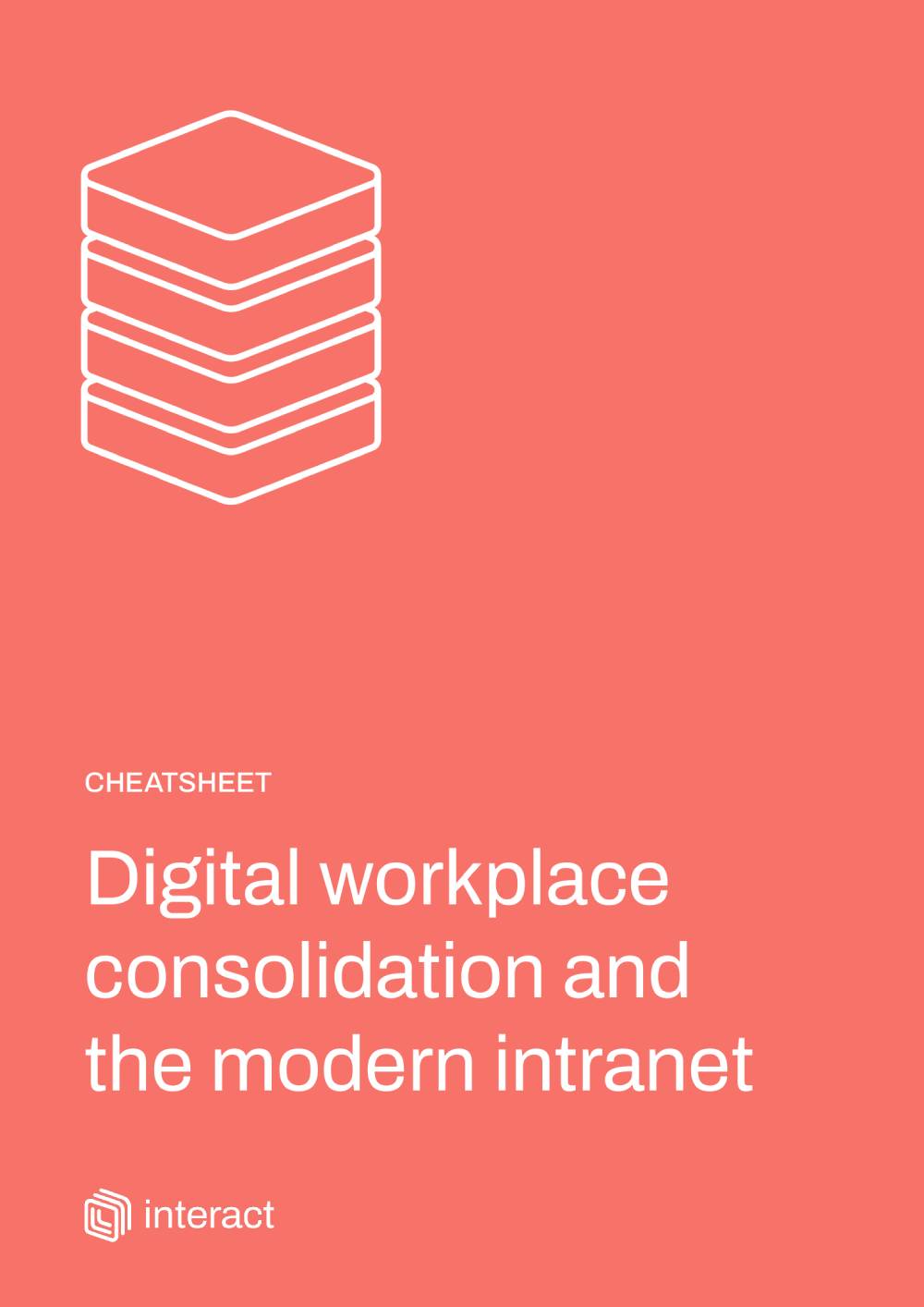Construction technology consolidation is a necessity today. With a wide range of employee roles, work locations, and compliance needs, construction companies are especially vulnerable to tech overload. This article explores why and how consolidation can help promote workplace safety, efficiency, retention, and more.
Technology overload is a reality for digital workplaces across sectors, and construction is no exception. Today, construction employees are often faced with too many apps and platforms, which leads to overwhelm, inefficiency, low engagement, and more.
Construction companies face several key challenges that are made worse by cluttered digital workplaces, including ensuring safety and compliance, serving the needs of deskless, desked, and on-the-move workers, and engaging employees in a tough labor market. Construction technology consolidation can address many of these issues and more. The right consolidation tactics will help companies get vital information in front of the right people, facilitate organization-wide collaboration, and work to engage every employee.
But when your workplace is already so overcrowded with technology, where do you begin? This article covers the ins and outs of tech consolidation for construction companies and demonstrates how a comprehensive, full-featured employee experience intranet can make a huge difference to consolidation success.
Your roadmap to digital workplace consolidation
Technology overload in construction today
An overloaded digital workplace doesn’t happen all at once. Solutions are added over time and, little by little, companies amass a great deal of platforms that often have singular purposes.
This is especially true in construction due to the nature of the sector’s workforce. With employees in both corporate and on-the-ground roles with varying responsibilities and differing levels of access to technology, it may have seemed necessary in the past to adopt different apps for different teams or departments. In reality, this leads to confusion and miscommunication.
Common apps in the construction sector include:
- Employee communication apps
- Employee newsletter platforms
- Apps to drive engagement through recognition, enterprise social networking, and more
- Collaboration platforms such as Slack or Teams
- “Shadow IT” technologies only used by one division or department
- Document management systems
- Idea management software
- Onboarding and offboarding software
- Workflow apps for tasks such as submitting expenses
- Data analytics software to measure employee engagement and productivity
- Survey tools
This isn’t a comprehensive list, but it should provide a general idea of just how many solutions companies have in play. According to research by Okta, the average large enterprise has over 211 apps in its digital workplace. This is problematic for several reasons.

Implications for employees
Employees confronted with too many apps face digital confusion. When the digital workplace is too crowded, they may forget which solution to use for which activities and where to find key information. Additionally, being expected to use too many different types of technology causes resistance among employees, making them less likely to adopt or regularly use the technology that’s necessary to keep the workplace running. Yet another issue is that having so many channels means workers may miss important updates due to the sheer volume of information and places to look for it.
All of these factors are especially compromising when it comes to employees who work on jobsites regularly, occasionally, or all of the time. These workers aren’t in front of a computer all day so they have limited time to engage with technology. They can grow especially frustrated when they can’t complete necessary tasks or easily find the people or information they need. This creates disengagement, and, with current labor shortages, companies can’t afford disengaged employees – construction technology consolidation is key to keeping them satisfied.
Implications for HR, comms, IT, and leadership teams
Sharing company information and news is essential in construction. There’s typically a lot going on, with many different projects at different stages all at once, and employees must be kept informed. This is made even more challenging by the need to reach those workers who are deskless some or all of the time. Having too many channels for comms messaging and HR information increases the difficulty even more.
Without a single dedicated tool for communication and knowledge management, it can be time-consuming to send and track communications. And when employees aren’t well informed about policies and procedures, leading to more inquiries to IT and HR.
In addition, the cost and workload associated with maintaining many different vendors can be detrimental to business goals. Plus, more apps in use means more opportunities for cybersecurity breaches.
Your roadmap to digital workplace consolidation
A path forward
Issues for employees, teams, and organizations mean companies are pushing for tech consolidation in many sectors, including finance, franchise, healthcare, retail, and (of course) construction.
One recent survey found that 95% of CIOs are planning for IT vendor consolidation within the next year. Another discovered that 90% of organizations are currently looking to consolidate using a unified IT platform. These leaders recognize the importance of consolidation to business success.
But if you’re deciding whether to embark on the journey to construction technology consolidation, the process can seem daunting. It’s important to examine the specific industry challenges that construction companies face, and how consolidation can improve them.

Considerations for construction technology consolidation
Construction companies experience unique challenges that make them especially vulnerable to the impacts of technology overload. These challenges are important to keep in mind during the construction technology consolidation process, as they help determine what you’ll need your streamlined digital workplace to do. Here are some considerations and problems that construction tech consolidation strategies should aim to solve.
Safety and compliance
Construction companies must adhere to many laws and regulations that cover everything from jobsite safety and working conditions to equipment inspection schedules and building codes. These regulations can be on a national, state, county, or city level, and are frequently changed and updated. Companies also have to devise and enforce internal rules to protect skilled workers against accidents on the job. All this information must be kept updated and accessible to the teams responsible for compliance and easy to share with others across the organization. Too many different channels can cause confusion and oversights.
Additionally, jobsite employees must know where to find information about their safety obligations and need to be notified promptly whenever rules and guidelines change. They also need to ensure they are up to date on any necessary trainings and certifications. With too many different platforms all of this may be hard to stay on top of, especially for workers who don’t use computers in their day-to-day roles.

Serving the unique needs of several types of employees
In the construction industry, a digital workplace must serve the needs of several types of employees with very different experiences and responsibilities. One of these groups made up of the jobsite workers mentioned above, who don’t often have computer access at work and need an easy way to gain information and complete digital workplace tasks on the go. They also need to be notified of important alerts or changes, for example, if a jobsite is unexpectedly closed.
Another group is made up of the employees who divide their time between corporate offices and the field, including project managers, safety managers, project architects, and more. These employees are crucial to a project’s success, and they often work cross-departmentally, so it’s essential that they can tap into the entire company. This proves difficult when they’re on the go, especially with several different platforms to deal with.
The third group of employees are the office-based workers who, like office-based workers in other sectors, need a comprehensive digital workplace to get things done. Construction office workers aren’t onsite at projects yet still need to be kept in the loop, so spaces to share information are critical.
With such differing needs, it’s no surprise that companies have so many different tech solutions in play. However, construction technology consolidation is essential to truly support all employees.
Your roadmap to digital workplace consolidation
Bridging gaps
Construction companies must bridge gaps, both operationally and culturally, to connect jobsite workers, corporate employees, and everyone in between.
With a workforce distributed across project sites, offices, and sometimes working from home, with varying access to technology, it’s hard to find the right information or people – and utilizing too many solutions can exacerbate this. It can take a lot of digging and back and forth to answer even the simplest of questions, leading to frustration, inefficiency, and errors.
An industry with so much going on needs a single platform on which to carry out team activities. The right digital workplace tools provide spaces for collaboration, including designated areas for employees to share information about projects and get in touch with coworkers with certain skills, in certain locations, or on certain jobs.
Construction companies have to unite not only on project-related activities but also culturally. It’s difficult to engage employees who aren’t in the same place, and it’s even harder when there are too many channels for communication and connection.
This is especially important right now, as the sector is seeing both increased demand for services and continuing labor shortages. Retention issues make it more necessary than ever to keep employees engaged and on board. Organizations need the right mix of culture-building tools to ensure recognition, employee listening, belonging, and more, and they need employees to use them.
Consolidating construction technology with an employee experience platform
An employee experience intranet platform can help construction companies address the challenges laid out above by providing a single, comprehensive tool that meets all digital workplace needs. The right full-featured intranet will have everything employees need in a single place to maintain compliance and safety, and to help serve and connect employees across roles, projects, and locations. A high-quality option should deliver:
- Personalized updates on company news and project milestones
- An organized, searchable home for essential policies, processes, and other documentation, including compliance and training information
- Mobile and desktop access to accommodate the needs of desk-based workers, jobsite workers, and workers who split their time between several locations
- A comprehensive people directory searchable by name, team, department, project, skills, location, and more, so that employees can find the right coworker to collaborate with right away
- Employee social networking features to boost connection and belonging across locations and roles, especially for hard-to-engage jobsite workers
- Features that facilitate appreciation and belonging for all employees, such as rewards and recognition tools or blog posts and newsletters that highlight accomplishments and milestones
- Dedicated digital spaces for specific teams and projects to get everyone on the same page and promote visibility throughout the company
- Self-service capabilities for HR and IT tasks
A good intranet solution will provide these capabilities and more, and serve as the go-to location for all of your digital workplace needs.

Construction technology consolidation has never been more important, and it’s a crucial step to meet the challenges the sector faces today. The right intranet software can make this happen by removing roadblocks to safety and compliance, helping many different types of workers do their jobs more effectively, and boosting connection and collaboration across locations and roles. In taking this step toward consolidation, construction companies can improve their digital workplaces and better prepare themselves to meet the needs of the future.


